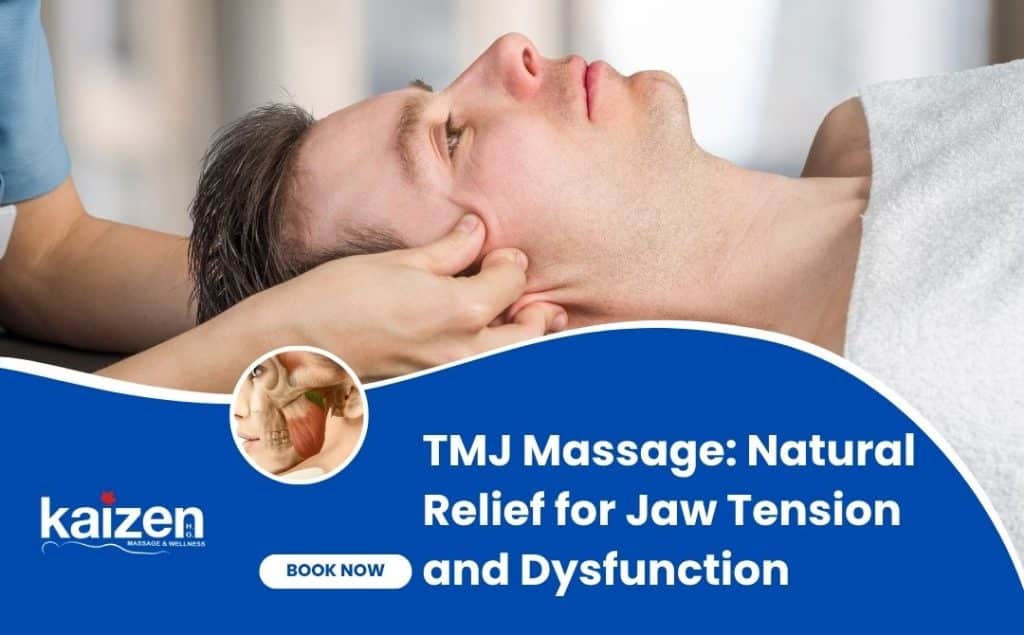What is the TMJ?
The temporomandibular joint, often referred to as the TMJ, plays a vital role in jaw function. It links the lower jawbone (mandible) to the temporal part of the skull, positioned just in front of the ears. This joint allows the jaw to move in several directions up and down, side to side, and slightly forward. Such movements are essential for actions like speaking, chewing food, yawning, and swallowing.
TMJ disorder (TMD) is an umbrella term for conditions causing pain, stiffness, or dysfunction in this joint and the surrounding muscles.
Why TMJ Massage Helps?
Many TMJ problems are muscle-related:
- Clenching or grinding teeth (bruxism)
- Stress and anxiety
- Postural issues (like forward head posture)
- Repetitive chewing or nail-biting Massage helps by:
- Reducing hypertonicity (over-tight muscles)
- Increasing blood circulation
- Improving lymphatic drainage
- Breaking up adhesions (knots)
- Restoring normal jaw movement

Common Muscles Addressed in TMJ Massage
- Masseter – powerful jaw-closing muscle along the cheek and jawline
- Temporalis is a wide, fan-like muscle on the head that helps move the jaw.
- The medial and lateral pterygoid muscles are found deep within the mouth and play a key role in controlling jaw motion and maintaining stability.
- The suprahyoid muscles, located beneath the jaw, support both swallowing and the opening of the mouth.
Massage Techniques Used
- Myofascial release: sustained pressure to release connective tissue tension
- Trigger point therapy: pressure on tight points to reduce referred pain
- Effleurage: gentle gliding to warm up tissues and promote circulation
- Compression and stretching: to lengthen tight fibers and improve flexibility

When TMJ Massage is Helpful
- Morning jaw stiffness from nighttime clenching
- Clicking/popping without major structural damage
- Jaw tension from dental procedures or orthodontics
- Tension headaches starting from temples or jaw
- General stress-related tightness
Note: Severe degeneration, acute infection, fractures, or tumors require medical care, not massage.
Benefits Beyond the Jaw
- Reduced frequency of headaches and migraines
- Lower stress and improved mood
- Better sleep due to less night clenching
- Easier chewing, swallowing, and speaking
Intraoral Massage: Targeting the Deeper Layers for Lasting Relief
What is Intraoral Massage?
Intraoral massage is a specialized therapy where a trained massage therapist wears medical gloves and works inside your mouth to release tension in muscles that cannot be fully reached from outside.
These muscles include:
- Medial pterygoid – often contributes to jaw deviation and deep tension
- Lateral pterygoid – important for opening, protruding, and side-to-side motion of the jaw

How it Works
- The therapist gently inserts a gloved thumb or finger along the inner cheek or near the molars
- Applies slow, precise pressure and small circular motions
- Sometimes combines with external massage for synergistic effects
- Sessions may feel strange at first, but are usually not painful and offer significant relief.
Unique Benefits of Intraoral Massage
- Releases deep-seated trigger points that cause radiating pain into teeth, ear, or temple
- Increases jaw opening and range of motion
- Can help unlock a “stuck” jaw or reduce deviations when opening
- Complements dental treatments and orthodontics by balancing muscle tension
- Helps chronic clenchers who get limited relief from surface massage
Who Should Consider Intraoral Massage?
- People diagnosed with TMD or myofascial pain syndrome
- Chronic teeth grinders (bruxism)
- Singers, actors, teachers, and musicians needing relaxed jaw mobility
- Those with tension headaches, facial pain, or ear fullness from muscle tightness
- Post-dental patients with lingering jaw tightness
Precautions & Safety
- Only performed by trained, certified therapists (e.g., RMTs with intraoral certification in Canada)
- Not suitable during:
- Active oral infections
- Open sores or recent oral surgery
- Severe TMJ degeneration with instability
- Hygiene is critical: therapists must use new medical gloves for each side of the mouth
Practical Tips to Support TMJ & Intraoral Massage
- Practice gentle jaw stretches (under guidance)
- Stay Away from hard foods, gum, or large bites during flare-ups
- Maintain good posture, especially when using phones/computers
- Use heat packs to relax tight muscles
- Consider mindfulness or relaxation exercises to reduce clenching triggers
Self-Massage Instructions
External TMJ self-massage:
- Place fingertips over your masseter (just below cheekbones)
- Use slow, gentle circular motions for 30–60 seconds
- Slide fingers up to temples (temporalis) and repeat
- Gently stretch jaw by opening mouth slightly and moving side to side
Safety tips:
- Stop immediately if pain sharpens or discomfort increases.
- Avoid pressing directly over the jaw joint itself
- Start gently; gradually increase pressure if comfortable
Posture & Daily Tips
- Avoid gum & hard foods during flare-ups
- Maintain upright posture (screen at eye level)
- Apply warm compresses to relax muscles
- Practice mindful relaxation & breathing to reduce clenching
Scientific References
- De Leeuw R, Klasser GD. Orofacial Pain: Guidelines for Assessment, Diagnosis, & Management. Quintessence, 2018.
- Durham J, et al. (2016). “Management of temporomandibular disorders.” BMJ, 352:i115.
- Fernández-de-Las-Peñas C, et al. (2015). “Myofascial trigger points and temporomandibular pain.”
- Current Pain and Headache Reports, 19(6):24.


